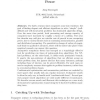322 search results - page 2 / 65 » On the Complexity of Reverse Similarity Search |
107
click to vote
SOFSEM
2000
Springer
15 years 2 months ago
2000
Springer
For half a century since computers came into existence, the goal of finding elegant and efficient algorithms to solve "simple" (welldefined and well-structured) problems ...
VLDB
2001
ACM
15 years 3 months ago
2001
ACM
Complex similarity queries, i.e., multi-feature multi-object queries, are needed to express the information need of a user against a large multimedia repository. Even if a user in...
DASFAA
2008
IEEE
15 years 5 months ago
2008
IEEE
Similarity search in complex databases is of utmost interest in a wide range of application domains. Often, complex objects are described by several representations. The combinatio...
JCB
2007
14 years 11 months ago
2007
The understanding of genome rearrangements is an important endeavor in comparative genomics. A major computational problem in this field is finding a shortest sequence of genome...
CEC
2009
IEEE
15 years 6 months ago
2009
IEEE
— Regulatory networks are complex networks. This paper addresses the challenge of modelling these networks. The Boolean representation is chosen and supported as a representation...


